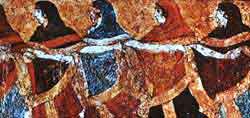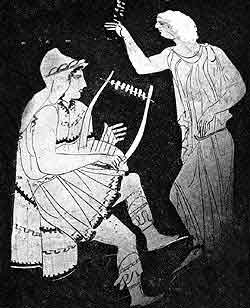
women dancing in a line
The ancient Greek theatrical dances are known only through artwork and written descriptions. The dance of tragedy had a dignified character and was known as emmeleia.The chorus were the primary dancers of the performance. All of their interludes (parodos and stasima) were danced. In addition, they sometimes danced or performed formal laments within acted scenes (kommoi).The entrance song (parodos) was in marching meter, anapests, and the choral interludes (stasima) were in complex lyric meters arranged in stanzas that reflected the patterns of the dance: strophe, antistrophe, epode. Actors danced also in the laments (kommoi) and in solo songs (Io's role requires dancing in Prometheus Bound). Many dances may have been mimetic of animal movements. Some dances were based on marriage dances, for instance that of Cassandra in The Trojan Women of Euripides. The choruses of tragedy often describe the flight of birds and wish they could fly too. Gesture was a part of choreography and could represent the words of the texts, cheironomia.
Sophocles was a famous dancer in his youth (he performed a victory hymn after the battle of Salamis before the entire city in the theatre as a teenager). He choreographed and danced in his own productions such as Nausikaa in which the ball game was a famous dance. The vase painting may show Sophocles as Thamyrus, playing the lyre. Euaion, the son of Aeschylus who was a popular actor in traged, ydancing as Argiope. the mother of Thamyrus.

Thamyrus by Sophocles the son of Aeschylus, Euaion is dancing the role of Argiope,(right). Thamyrus is played by Sophocles